Leaves of different tree species. Tree leaves. tree structure
BIRCH TREE- one of the most beautiful and poetic plants of the Russian forest. This is a fast growing light-loving tree with dense carved leaves on thin drooping branches by the age of 40-50 reaches 25-30 meters in height.
OAK - On the the globe there are up to 600 species of oak, in our country - up to 20 species. One of them is pedunculate, or summer (beech family) occupies the main area of oak forests.
ASPEN- one of the types of poplars. Aspen is a fast-growing dioecious tree 20-30 meters in height, lives up to 80-100, and sometimes more years. The trunk is straight, semi-woody.
ROWAN- a small tree of the Rosaceae family with a rounded compact crown, with white flowers in spring and with red-orange clusters of hanging fruits in autumn.
POPLAR- a genus of deciduous trees, willow family. Differs in unusual speed of growth, trees of large sizes (25-30 m), a trunk is rather harmonous, with light gray bark, krone spreading, leaves are more often ovoid; poplar is unpretentious, easily propagated by seeds and cuttings.
VYAZ. Of the elm family, the most common is the smooth elm. In the first years it grows very quickly, by the age of 40 it reaches a maximum of 20-30 meters in height and over one meter.
LINDEN . The genus of lindens includes several hundred species. In Russia, the most common small-leaved linden is a tree up to 30 meters in height, up to one meter in diameter. She lives 300-400 years, and sometimes more.
ALDER(black or sticky) named after dark color bark of old trees and because young buds, shoots and leaves are sticky. It is a fast growing tree of the birch family. By the age of 10 it reaches 10-12 meters, by 50 it has a height of 30 meters, a diameter of 40-60 centimeters, lives up to 100-300 years, blooms in early spring brown-brown earrings.
The leaf of a tree is one of the most variable and interesting organs ever created by nature. Classic shape leaf - a flat plate, narrow or wide. The leaf is connected to the stem at a point called a knot by means of a petiole of various lengths. The latter may, however, be absent (then the leaf is called sessile). The shape of the leaf blade can be solid with smooth edges (like a magnolia), or it can have jagged edges, like a chestnut or cherry. If there is only one leaf blade on the petiole, then such a leaf is called simple. Sometimes there are several leaflets on one petiole, connected to a common (rod) petiole with the help of petioles. Such leaves are called compound. Complex leaves, for example, are characteristic of Robinia (one of the varieties of white locust).
By the shape of the leaf, it is easy to identify many types of plants.
This section presents drawings of leaves, flowers, crowns of trees common in Russia. Larch, spruce, pine, juniper, elm, oak, alder, birch, hazel, linden, aspen, willow, bird cherry, mountain ash, acacia, chestnut, maple, ash, elder, plum.
|
Birch dangling |
Hazel ordinary |
||
|
|
How does a tree grow from seed to fruit? We teach branches of mountain ash, birch, poplar, maple, oak with a child. Acquaintance with the tree begins for the child in his earliest childhood. Each yard has its own good-natured giant who will gladly shelter from the scorching sun, rain, share fallen leaves and dry twigs for all kinds of games.
However, many children perceive trees as nameless satellites, not thinking about the fact that each of them has its own name, has a complex structure and performs important tasks. Therefore, with a deeper study of trees, kids make many discoveries for themselves.
For example, children will be interested to know what parts a tree consists of. To do this, we use a schematic image of a tree and talk about each part of it:

- The roots of a tree are its foundation. They feed the tree by absorbing the nutrients dissolved in the water, and also keep it upright. The larger the tree, the richer its root system.
- The trunk of a tree is, as it were, its body. All the substances extracted by the roots pass up the trunk, while branches begin to depart from the trunk. It is important to note that a real tree has one trunk, but shrubs have several, even large, trunks.
- Tree branches - support for leaves; it is on the branches that buds are formed, from which leaves and flowers then appear. Nutrients also pass through them. Over time, the branches become wider and harder (woody), and new branches appear from them.
- The foliage of a tree is an organ that allows the tree to exchange substances with environment. Thanks to the leaves, the tree absorbs carbon dioxide harmful to humans from the air, here, under the action of sunlight, carbon dioxide is formed from it. organic matter, and through the leaves, the tree releases the oxygen we breathe out.
- All the leaves and branches of the tree form its crown - a lush hat that gives shade and shelters us from the rain.
Having studied the structure of a tree, you can proceed to the next stage - to find out how it comes into being. Where and how do trees grow? The answer to this question can be represented in the form of a circular diagram.

So, let's take it all apart life cycle fruit tree:
A seed is the source of life for every plant, including a tree. It contains a small germ and an initial supply nutrients, which the embryo needs in order to germinate through the seed coat. Once in the soil, the embryo begins to actively develop, pecks through the shell, grows and puts out roots, with which it absorbs the substances necessary for its growth from the ground.
After many years, the embryo turns into a tree, which, having reached a certain age, acquires the ability to reproduce its own kind.
In spring, buds form on the branches of a tree, in which an organ of amazing beauty and smell develops - a flower.
The flower of a fruit tree is arranged in such a way that when pollinated (by wind or insects), a small rudiment of the fruit is formed in it.
The fruit of a tree is the result of its life activity. The fruit contains seeds. In order for the seeds to spread as far as possible, nature has made most of the fruits tasty and attractive to animals and people, who, by collecting fruits, contribute to the spread of seeds over long distances. Uncollected fruits fall from the tree, rot, and after that the seeds fall into the soil.
The development of a tree can be considered from any moment: starting with a fruit, a kidney, a seed. Each stage can be considered the beginning of the life cycle.
The life cycle of a tree depends greatly on the time of year.
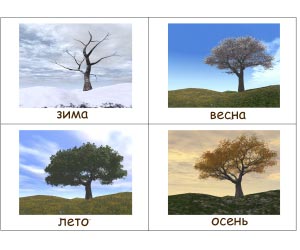
The beginning of its development and rapid growth occurs in the spring, when buds are actively formed on the branches, from which leaves and flowers subsequently appear. No wonder it is said that in spring the trees come to life after a winter sleep.
In summer, the trees appear before us in all their glory. They constantly interact with the outside world, feed, replenish the reserves of substances necessary for their life. The leaves of the trees are constantly working in the summer, turning into a real processing factory. carbon dioxide and the production of oxygen and nutrients from it.
In autumn, all vital processes in the tree decline: the daylight hours become shorter, and the amount of sunlight is not enough to form new chlorophyll molecules in the leaves, so the foliage gradually changes its color and falls off. Leaf fall not only saves the tree's strength, which it will need to survive the harsh winter, but also saves tree branches from breaking off, which can occur under the weight of the fallen snow.
In winter, the tree seems to freeze. It economically spends the reserves accumulated over the summer and is looking forward to the arrival of the first spring warmth.
But not all trees go through such a cycle of transformations, but only those that have leaves, that is, deciduous ones. But the trees, whose branches are covered with needles - needles (coniferous) all winter look the same as in summer.
Most famous conifer tree- this is a spruce. Of course, it became famous thanks to the Russian tradition of decorating spruce branches on New Year's Eve. Spruce reproduces with the help of cones that form during the summer.

But of the deciduous trees, the most common are:
- Rowan is a tree with bright berries and beautiful serrated foliage, which looks especially impressive in autumn. There is a version that it was called mountain ash because its leaves are quite small and, when the wind blows, they tremble, causing ripples in the eyes of the one who looks at it.

- Birch is a symbol of Russia, unique tree with white bark. Its very name comes from Slavic word, meaning "shine, turn white." The birch is also interesting for its flowers, which look like earrings, and the fact that its branches are very long and thin, they seem to hang down.

- Poplar is a frequent companion of human habitation. Poplars are planted near houses because they grow quickly - which means that they begin to purify the air early and absorb excess moisture well. In the wild, poplar is often found in wetlands, for which it got its name, which in Slavic means "marshy place, swamp." Poplar fruits are boxes from which seeds are spilled, covered with many silky hairs - poplar fluff. This fluff gives people a lot of inconvenience, so poplars are often cut, leaving only non-fruitful branches at the top.

- Oak - a tree - a giant, especially revered by our ancestors. Its fruits - acorns - were used to make a drink that replaces coffee, but oak bark and wood, which is distinguished by its strength and beautiful color, have found even greater use among people.

- Maple - the owner beautiful leaves with sharp edges. A sweet aromatic maple syrup is obtained from its juice.

- Elm is a tree, wood, branches and bark of which people have used for the manufacture of furniture, tools and even weapons since ancient times. Elm bark (bast) is strong and flexible, various objects were tied to it, for which the tree got its name. Shoes were woven from bast.

- Chestnut is a tree with unusual fruits, the core of which resembles a nut. It is believed that the word "chestnut" has the same root with the word "porridge", since chestnut fruits were often eaten.

- Willow is a tree with unusual long branches and narrow leaves. Its name comes from the word "twist", which is explained by the main use of willow branches - baskets were woven from them, furniture was woven.
In order to better remember the names of trees, you can play simple game: shuffle the cards with the image of the leaves and the trees themselves, and then match them and name them.
Images of leaves are more visible in coloring pages, where you can see their contour and give color depending on the expected season and shades characteristic of a particular tree.
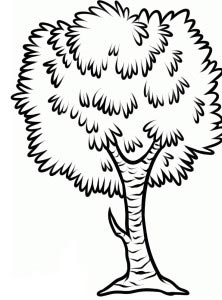
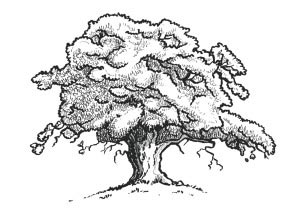





![]()
While the child is working with coloring, you can ask him thematic questions, read poems or make riddles to consolidate what he has learned. For example, these:
And graceful and beautiful, she grew up by the river ... (willow).
They protect both houses and fields from wind and moisture ... (poplars).
The Russian land does not even need roses, its relatives paint ... (birches).
And handsome, and strong, and useful, he generously shares own juice. ... (maple).
And in the heat, and in a blizzard, it is equally beautiful ... (spruce).
If there are several children, you can arrange a mini-quiz on the material covered, and use bouquets of live or cardboard bright leaves or tree fruits (for example, apples) as prizes.
In this article, we have collected material on the topic "tree leaves" and "tree structure". Acquaintance with the tree begins for the child in his earliest childhood.
Each yard has its own good-natured giant, who will gladly shelter from the scorching sun, rain, share fallen leaves and dry twigs for all kinds. However, many children perceive trees as nameless satellites, not thinking about the fact that each of them has its own name, has a complex structure and performs important tasks. Therefore, with a deeper study of trees, kids make many discoveries for themselves.
For example, children will be interested to know what parts a tree consists of. To do this, we use a schematic image of a tree and talk about each part of it:

- The roots of a tree are its foundation. They feed the tree by absorbing the nutrients dissolved in the water, and also keep it upright. The larger the tree, the richer its root system.
- The trunk of a tree is, as it were, its body. All the substances extracted by the roots pass up the trunk, while branches begin to depart from the trunk. It is important to note that a real tree has one trunk, but shrubs have several, even large, trunks.
- Tree branches - support for leaves; it is on the branches that buds are formed, from which leaves and flowers then appear. Nutrients also pass through them. Over time, the branches become wider and harder (woody), and new branches appear from them.
- The foliage of a tree is an organ that allows the tree to exchange substances with the environment. Thanks to the leaves, the tree absorbs carbon dioxide harmful to humans from the air, here organic substances are formed from it under the action of sunlight, and through the leaves the tree releases the oxygen that we breathe.
- All the leaves and branches of the tree form its crown - a lush hat that gives shade and shelters us from the rain.
Having studied the structure of a tree, you can proceed to the next stage - to find out how it comes into being. Where and how do trees grow? The answer to this question can be represented in the form of a circular diagram.

So, we analyze the entire life cycle of a fruit tree:
A seed is the source of life for every plant, including a tree. It contains a small germ and the initial supply of nutrients that the germ needs in order to germinate through the seed coat. Once in the soil, the embryo begins to actively develop, pecks through the shell, grows and puts out roots, with which it absorbs the substances necessary for its growth from the ground.
After many years, the embryo turns into a tree, which, having reached a certain age, acquires the ability to reproduce its own kind.
In spring, buds form on the branches of a tree, in which an organ of amazing beauty and smell develops - a flower.
The flower of a fruit tree is arranged in such a way that when pollinated (by wind or insects), a small rudiment of the fruit is formed in it.
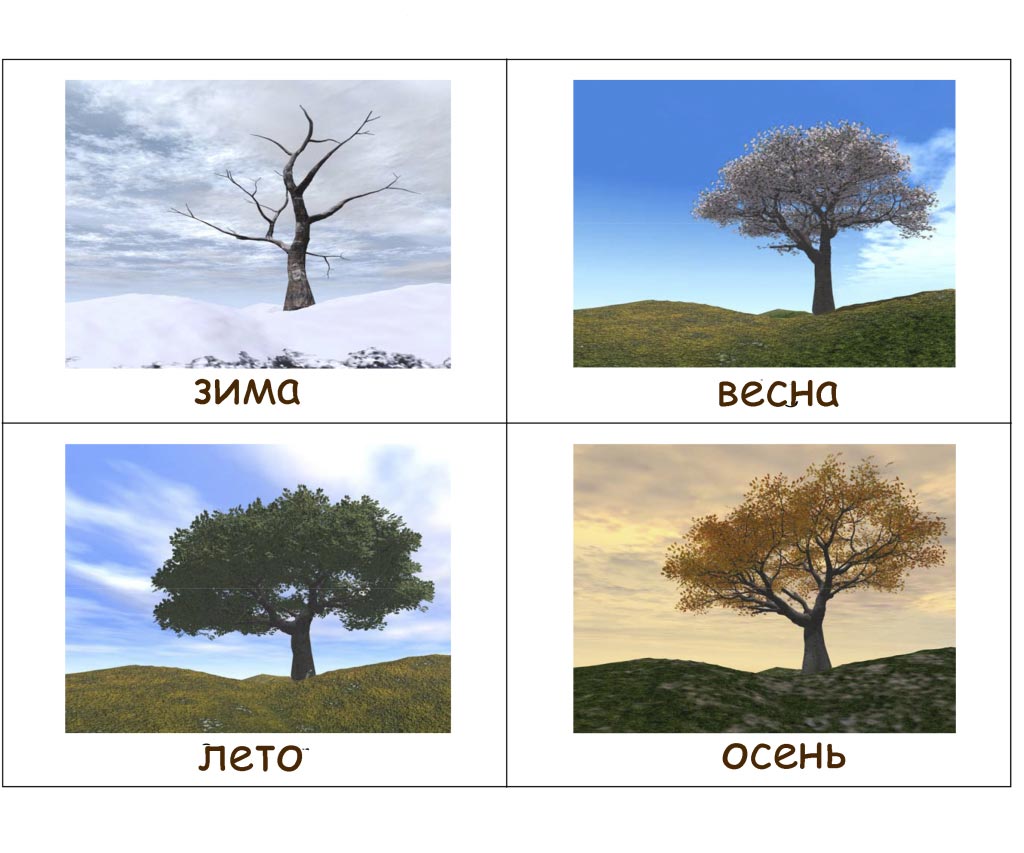
The beginning of its development and rapid growth occurs in the spring, when buds are actively formed on the branches, from which leaves and flowers subsequently appear. No wonder it is said that in spring the trees come to life after a winter sleep.
In summer, the trees appear before us in all their glory. They constantly interact with the outside world, feed, replenish the reserves of substances necessary for their life. The leaves of the trees are constantly working in the summer, turning into a real factory for processing carbon dioxide, and producing oxygen and nutrients from it.
All vital processes in the tree are on the decline: daylight hours become shorter, and the amount of sunlight is not enough to form new chlorophyll molecules in the leaves, so the foliage gradually changes its color and falls off. Leaf fall not only saves the tree's strength, which it will need to survive the harsh winter, but also saves tree branches from breaking off, which can occur under the weight of the fallen snow.
The tree seems to freeze. It economically spends the reserves accumulated over the summer and is looking forward to the arrival of the first spring warmth.
But not all trees go through such a cycle of transformations, but only those that have leaves, that is, deciduous ones. But the trees, whose branches are covered with needles - needles (coniferous) all winter look the same as in summer.
The most famous coniferous tree is. Of course, it became famous thanks to the Russian tradition of decorating spruce branches on New Year's Eve. Spruce reproduces with the help of cones that form during the summer.
But of the deciduous trees, the most common are:
- - a tree with bright berries and beautiful jagged foliage, which looks especially impressive in autumn. There is a version that it was called mountain ash because its leaves are quite small and, when the wind blows, they tremble, causing ripples in the eyes of the one who looks at it.

- Birch is a symbol of Russia, a unique tree with white bark. Its very name comes from a Slavic word meaning "shine, turn white." The birch is also interesting for its flowers, which look like earrings, and the fact that its branches are very long and thin, they seem to hang down.

- Poplar is a frequent companion of human habitation. Poplars are planted near houses because they grow quickly - which means that they begin to purify the air early and absorb excess moisture well. In the wild, poplar is often found in wetlands, for which it got its name, which in Slavic means "marshy place, swamp." Poplar fruits are boxes from which seeds are spilled, covered with many silky hairs - poplar fluff. This fluff gives people a lot of inconvenience, so poplars are often cut, leaving only non-fruitful branches at the top.
- Oak - a tree - a giant, especially revered by our ancestors. Its fruits - acorns - were used to make a drink that replaces coffee, but oak bark and wood, which is distinguished by its strength and beautiful color, have found even greater use among people.

- Maple is the owner of the most beautiful leaves with sharp edges. A sweet aromatic maple syrup is obtained from its juice.

- Elm is a tree, wood, branches and bark of which people have used for the manufacture of furniture, tools and even weapons since ancient times. Elm bark (bast) is strong and flexible, various objects were tied to it, for which the tree got its name. Shoes were woven from bast.

- Chestnut is a tree with unusual fruits, the core of which resembles a nut. It is believed that the word "chestnut" has the same root with the word "porridge", since chestnut fruits were often eaten.

- Willow is a tree with unusual long branches and narrow leaves. Its name comes from the word "twist", which is explained by the main use of willow branches - baskets were woven from them, furniture was woven.

In order to better remember the names of the trees, you can play a simple game: shuffle the cards with the image of the leaves and the trees themselves, and then match them and name them.
From the leaves you can make a very interesting visual aid for children. To do this, you need to collect leaves different types and laminate them.

Cut out the leaves slightly stepping back from the edge.
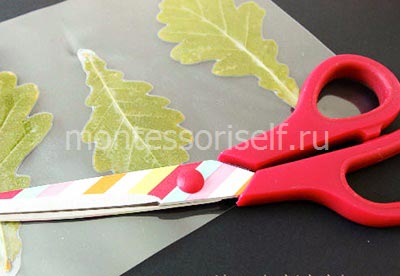
We get a living manual for the study of leaf types.
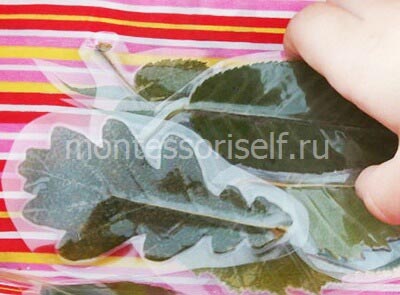
Print on a separate piece of paper the names of the trees from where you collected the leaves. The name of the tree is compared with the leaf itself, studying and memorizing its shape and structural features.

Images of leaves are more visible in coloring pages, where you can see their contour and give color depending on the expected season and shades characteristic of a particular tree.






While the child is working with coloring, you can ask him thematic questions, read poems or make riddles to consolidate what he has learned. For example, these:
And graceful and beautiful, she grew up by the river ... (willow).
They protect both houses and fields from wind and moisture ... (poplars).
The Russian land does not even need roses, its relatives paint ... (birches).
And he is handsome, and strong, and useful, he generously shares his own juice. ... (maple).
And in the heat, and in a blizzard, it is equally beautiful ... (spruce).
If there are several children, you can arrange a mini-quiz on the material covered, and use bouquets of live or cardboard bright leaves or tree fruits (for example, apples) as prizes.
Video: What is a tree?


